Some movies become audience favorites because their protagonist is such a unique character (or an actor creating a character with such consummate craft) that every scene in which the actor appears onscreen keeps the audience on the edge of its seats. Such films are rarely made by large studios. Instead, they tend to be independent films where a filmmaker's artistic vision is not liable to be compromised by "the suits" or a script subject to a committee's editing and revisions.
According to Wikipedia:
"An appeal to pathos causes an audience not just to respond emotionally, but to identify with the writer's point of view -- to feel what the writer feels. In this sense, pathos evokes a meaning implicit in the verb 'to suffer' -- to feel pain imaginatively. Perhaps the most common way of conveying a pathetic appeal is through narrative or story, which can turn the abstractions of logic into something palpable and present. The values, beliefs, and understandings of the writer are implicit in the story and conveyed imaginatively to the reader. Pathos thus refers to both the emotional and the imaginative impact of the message on an audience, the power with which the writer's message moves the audience to decision or action."
When recalling unforgettable characters, three films quickly come to mind. Shot on three different continents with three wildly different narratives, each film comes alive with some of the strangest plot twists one could imagine. Each has been crafted with such grace and skill that all one can do is applaud the film's artistic vision and dramatic integrity.
* * * * * * * * * * * * * *
Written and directed by Marcos Carnavale, Anita stars Alejandra Manzo as a young woman with Down syndrome whose life is shattered after a terrorist bomb explodes in her neighborhood.
Anita Feldman and her mother, Dora, live above a small stationary store in Buenos Aires. Anita's brother, Ariel, is a tense business executive whose obsession with soccer causes him to renege on his promise to take Anita to the zoo. Although they have a long-established dance routine in which he pretends to be the "turdy monster" whenever he greets Anita, Ariel's devotion to his developmentally disabled sister is genuine.
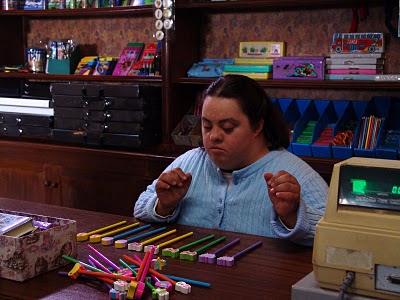
Alejandra Manzo as Anita Feldman
On July 18, 1994, a terrorist attack on the Acociacion Mutual Israelita Argentina (a Jewish Community Center in Buenos Aires) killed 85 people and injured many more. In Carnavale's film, Anita's mother has just left to run an errand to the AMIA building and promised her daughter that she will return "when the big hand [of the clock] hits the top." Dora is killed when a car bomb explodes. The blast from the explosion knocks Anita off a ladder as she tries to tidy up in the store.
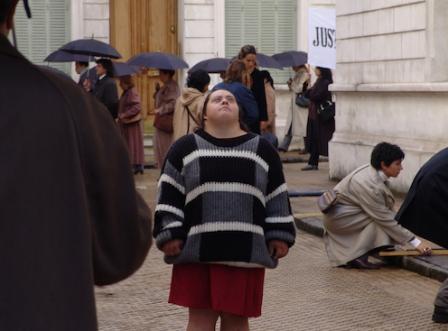
Alejandra Manzo as Anita Feldman
As Anita crawls out of the wreckage and heads into the street, she has no way of knowing that her mother is dead. Because of her limited vocabulary and difficulty communicating with strangers, she finds it hard to identify herself or even ask for help. Although in her late teens, the only name by which she knows her mother is "Mommy." Anita doesn't know her home address or how to contact her brother.
What Carnavale's film demonstrates is just how easy it is for someone like Anita to become invisible or be treated as an annoyance in a big city. As she wanders the sidewalks of Buenos Aires in a daze, people rush by her.
- A street performer tells Anita to move away from his spot and stop cramping his style.
- As she leaves the examining room in a local hospital, no one notices her exit in the midst of a crisis.
- A drunk photographer gives Anita shelter for two nights, but eventually ditches her on a city bus.
- The owner of a small Chinese grocery store keeps accusing Anita of trying to steal food until the owner's mother invites the confused young woman to dinner.
- A scavenger finds Anita hiding under a highway during a downpour and brings her home to his sister, who is a registered nurse.
Meanwhile, Ariel and his wife have all but given up hope that Anita could still be alive. When word finally reaches them that she has been found, Ariel is afraid the news could be a hoax.
Although there is much to admire in Anita, this film is no tearjerker. Anita uses what little knowledge she can access in order to survive (Alejandra Manzo gives a breakout performance in the title role, mostly just by being herself). Anita is a magnificent story -- a film that should not be missed. Here's the trailer:
* * * * * * * * * * *
An accordion proves to be a surprisingly helpful tool for luring homeless children away from a life of drugs, prostitution, and crime in Pa-Ra-Da. Marco Pontecorvo's film relives what happened when Miloud Oukili (a French-Algerian clown from the Annie Fratellini circus school) traveled from Paris to Bucharest in 1992. Only three years had passed since the Romanian Revolution of 1989 and Nicolae Ceausescu's fall from power.
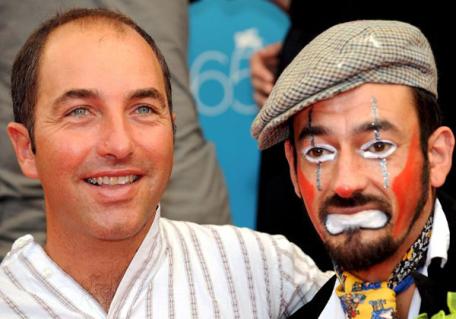
Filmmaker Marco Pontecorvo with Miloud Oukili
To his horror and great sadness, Oukili found large numbers of street children (boskettari) living in the city's sewers, sniffing glue out of plastic bags, and struggling to cope with the violence, pedophilia, drugs, rape, and poverty that defined their lives. While attempting to gain their trust, the Parisian went to such extremes as sleeping in the sewers with the children, trying to teach them about self respect, and working with local social workers to try to find a way to reach out to a subset of children that Romanian society was content to let wallow in shit.
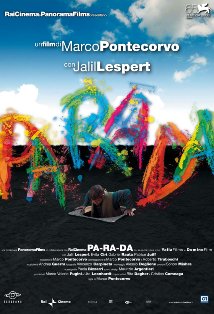
Poster art for Pa-Ra-Da
Oukili's success in creating a children's circus company with the boskettari helped prove to corrupt police officers, jaded social workers, and callous diplomats that the street children -- like everyone else -- were human beings. After their initial success performing in Bucharest's main square, Parada became the name of the established circus company that still travels around Europe with its own show, carrying a message of friendship, solidarity, and hope.
Established in 1996, the Parada Foundation is now a Romanian NGO whose mission is to support homeless children, young people, and families through its social and educational programs. However, "the thousand children who have been saved are nothing compared to the thousands still living on the streets who know nothing of joy or hope," insists Oukili.
Pontecorvo's first feature film stars Jalil Lespert as Miloud (who was in his early twenties when he traveled to Bucharest). Due to funding problems, it took seven years to complete Pa-ra-da. Given the director's relative lack of experience, a documentary-style approach was thought to be the ideal solution for telling the story (Pontecorvo confesses his cast and crew literally followed Oukili's footsteps). The movie was shot on location, using some of the exact spots (such as Bucharest's train station) where Miloud had worked.
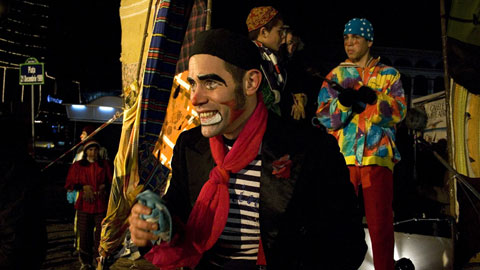
Jalil Lespert as Miloud Oukili
The film rests largely on the shoulders of Jalil Lespert, whose portrayal of Miloud shows a clown with a conscience, a man who inspires a friendly social worker -- as well as the street children themselves -- to believe that Bucharest's homeless kids are entitled to a better life. Miloud arranges for the children to buy food instead of glue, gain entry to a public bathhouse, and get hot food from a soup kitchen. As he begins to sense which children have a gift for mimicry, juggling, and who can draw, he encourages them to develop their artistic talents while trapped in a brutal, soul-crushing lifestyle.
This is not a "feel-good" movie in which everyone ends up smiling and covered in flowers. One young girl is raped by the authorities. Another (who dreamed of becoming a dancer) is beaten to death after escaping from an orphanage. A young man who had been a leader for a group of street children dies of an overdose while asleep on a park bench. An angry, immature, pregnant 13-year-old girl named Tea gives birth to an infant without understanding why she can't take her baby to live with her in the city's sewers.
Throughout the film there is the constant threat of police action and a never-ending parade of Romanians of every age sniffing glue. Among the children who shine are Robert George Vileanu as Cristi (a young boy who likes to draw but is afraid of heights), and Florin Precup as Vlad, a friend of Tea's who has just run away from his home in the country and arrived in Bucharest.
While the poverty and lifestyle of Bucharest's street children could depress anybody, this is the kind of film that shows exactly why "bleeding heart liberals" are needed in the world. As Pontecorvo explains:
"I was looking for a story that would hit me in the pit of my stomach. It's enough to go to the suburbs of Paris or any other great metropolis to find children whose childhood has been denied (you don't have to go to Bucharest). But from a cinematic point of view, it was like a modern fairy tale with a happy ending, with thousands of children being saved. This spirit made the story important because no one likes to see their dirty laundry aired in public. I didn't want to finish with a happy ending. While I wanted people to be hopeful, I also wanted people to see that there is another reality. It puts your feet on the ground."
More than many other films, Pa-ra-da demonstrates the importance of art, magic, laughter, and hope in pointing an impoverished child toward a brighter future. Here's the trailer:
* * * * * * * * * * *
Whether it involves a starring or character role, a career marked by longevity is the goal of every actor. That's one reason why watching Martin Landau's return to the silver screen in a beautifully crafted independent film shot in San Francisco's Tenderloin District is so thrilling. If Landau's name doesn't ring a bell, you might remember him from his appearances on Entourage or his Academy Award winning performance as Bela Lugosi in Tim Burton's nostalgic black-and-white film, Ed Wood.
As an aging eccentric who once won the lottery, Landau (who is also executive producer of Harrison Montgomery) handily steals the show from a much younger cast. It is a stunning display of craft communicating dramatic truth that will melt the hardest of hearts.
Octavio Gomez Berrios makes a strong impression as Ricardo Papa, a small-time Tenderloin drug dealer and starving artist whose talent remains unfufilled. Ricardo lives in a seedy Tenderloin apartment building whose inhabitants include the kindly Mrs. Cutsworth as well as a motley group of junkies, prostitutes, and thugs. One of Ricardo's street friends, Maurice, is a not-very-bright black hustler with delusions of grandeur who wants a cut of Ricardo's drug earnings.
Living directly below Ricardo is Harrison Montgomery (Martin Landau), an eccentric old geezer who has spent years watching Wheel of Fortune. Possibly autistic, Harrison believes that he has discovered a secret meaning in the way numbers are spelled out across the daily puzzles seen on the game show. Across the hall from Ricardo is Margot, a single mother trapped in an abusive relationship with a manipulative older man who pays some of her bills but continues to sabotage Margot's artistic aspirations.
Gary can barely tolerate Margot's 13-year-old daughter Lattie, a precocious piece of work who likes to snoop around the building, spy on Ricardo, and has no concept of boundaries. When a series of Ricardo's drug deals go bad (and his supplier threatens the young artist's life), it is Lattie's quick thinking -- along with Harrison Montgomery's long-awaited miracle -- that save the day.
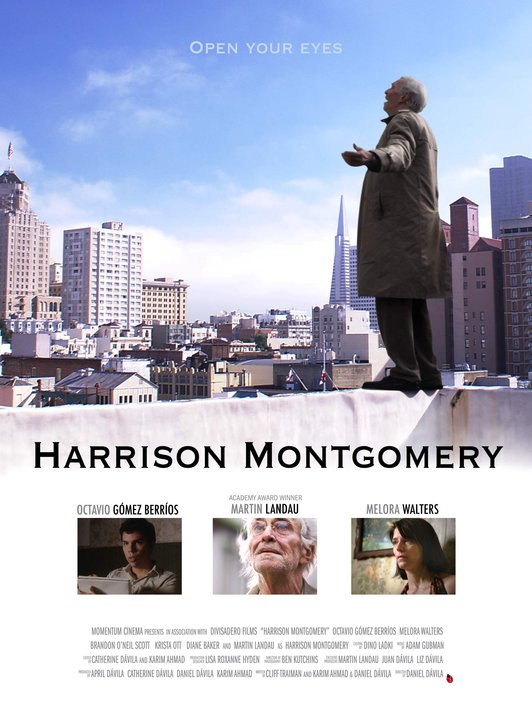
Poster art for Harrison Montgomery
Directed by Daniel Davila (who co-wrote the screenplay with Karim Ahmad), Harrison Montgomery is a fable for modern times (much like David Kaplan's appealing Year of the Fish). It doesn't add an ounce of glamour to the squalor of the Tenderloin, but does benefit immensely from Adam Gubman's musical score and Michele Collier's drawings (animated by Matt Gulley) which winningly bring Ricardo's amateur pencil sketches to life.
While this film is brutally realistic in its depiction of drug deals gone bad and people living in rundown resident hotels, its ending is poignant, endearing, and quite remarkable. I can't remember experiencing such an uplifting climax to a film in a long, long time.
The critical things you should know about Harrison Montgomery are that:
- This film will never bore you.
- This film will never disappoint you.
- This film will inspire you.
- This film will leave you feeling emotionally cleansed and spiritually refreshed.
To read more of George Heymont go to My Cultural Landscape
